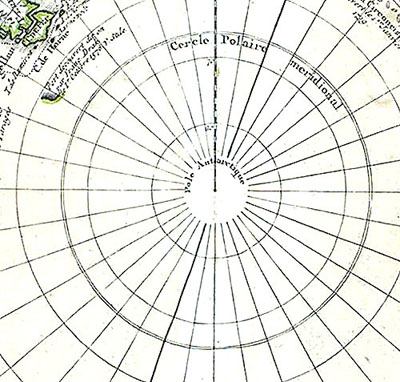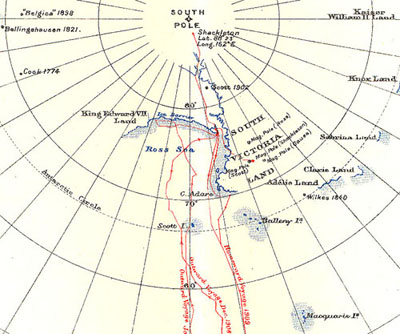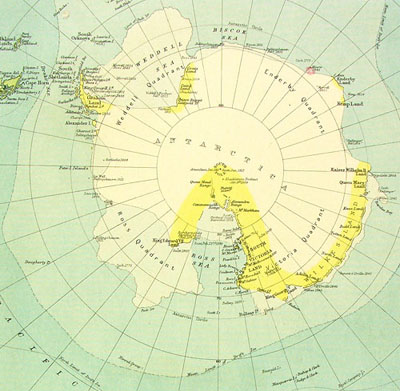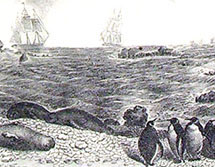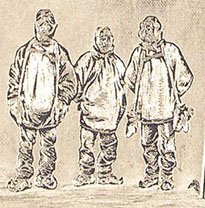Antarctica
| Eighteenth century map-makers such as Guillaume de L’Isle began to put only information that could be scientifically proven on their maps. De L’Isle’s map of the South Pole (above) shows a blank space waiting to be explored. Click on the map to see more. This map shows how little was known about the Antarctic even by the early twentieth century. It is from The Heart of the Antarctic: being the story of the British Antarctic Expedition 1907-1909 by Ernest Shackleton. The picture of explorers on the right is from the front cover of the same book. Shackleton got to within 97 miles of the South Pole before food shortages made him turn back. Click on the images to see more. The above map of Antarctica is from an atlas published in 1917. Click on the image to see more. | Antarctica is a frozen continent surrounded by sea. It was not discovered until the nineteenth century. In the sixteenth and seventeenth centuries map-makers like Mercator filled the southern hemisphere with a huge unknown southern continent. In the eighteenth century James Cook’s voyage, which crossed the Antarctic Circle, proved that the unknown southern continent as shown on earlier maps did not exist. Fabian Bellingshausen sailed around the polar region in 1819-21. He was the first to see the Antarctic mainland. In 1841 James Clark Ross travelled south until he reached a great wall of ice, now known as the Ross Ice Shelf in the Ross Sea. Whaling and sealing ships saw other parts of the Antarctic coast and by the 1850s the outline of the continent was known. This picture shows seals and penguins on Macquerie Island. It is from a 1945 edition of Bellinghausen's account of his voyage. You can see Macquerie Island on the map of Shackleton's journey on the left. Click on the image to see more Antarctic conditions are dangerous: travellers face hunger, exhaustion, cold, frostbite and difficult terrain. At the start of the twentieth century Antarctica’s coastline was not fully mapped and no one had gone far inland. The Sixth International Geographical Congress of 1895 named Antarctica as the last great challenge of exploration. Between 1897 and 1917 nine nations sent a total of sixteen expeditions south. These included scientific research projects as well as feats of endurance like the famous race for the South Pole between Robert Scott and Roald Amundsen (1911-1912). Expeditions continued to go to Antarctica throughout the twentieth-century. Among these was the Commonwealth Trans-Antarctic Expedition (1955-1958) led by Vivian Fuchs (an Honorary Fellow of St John’s College). The mapping of Antarctica was obstructed by its covering of ice. The rock continent under the ice was not fully mapped until the 1980s. This was made possible by the development of technologies such as echo sounding (invented by a team of Scientists from the Scott Polar Research Institute at Cambridge University). The Antarctic is still an important location for research in many fields, including climate change. |
